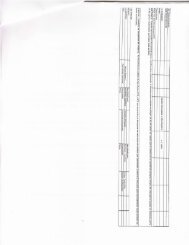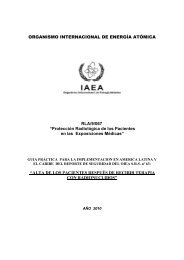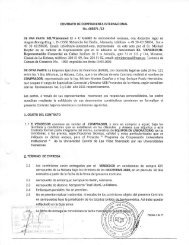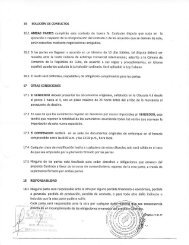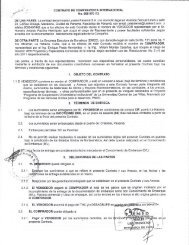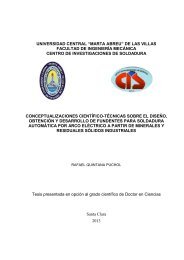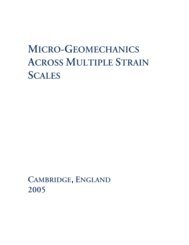Create successful ePaper yourself
Turn your PDF publications into a flip-book with our unique Google optimized e-Paper software.
410<br />
1. Introduction<br />
L. J<strong>in</strong>g, J.A. Hudson / International Journal of Rock Mechanics & M<strong>in</strong><strong>in</strong>g Sciences 39 (2002) 409–427<br />
Because <strong>rock</strong> <strong>mechanics</strong> modell<strong>in</strong>g has developed for<br />
the design of <strong>rock</strong> eng<strong>in</strong>eer<strong>in</strong>g structures <strong>in</strong> different<br />
circumstances and different purposes, and because<br />
different modell<strong>in</strong>g techniques have been developed,<br />
we now have a wide spectrum of modell<strong>in</strong>g and design<br />
approaches. These approaches can be presented <strong>in</strong><br />
different ways. A categorization <strong>in</strong>to eight approaches<br />
based on four <strong>methods</strong> and two levels is illustrated <strong>in</strong><br />
Fig. 1.<br />
The modell<strong>in</strong>g and design work starts with the<br />
objective, the top box <strong>in</strong> Fig. 1. Then there are the eight<br />
modell<strong>in</strong>g and design <strong>methods</strong> <strong>in</strong> the ma<strong>in</strong> central box.<br />
The four columns represent the four ma<strong>in</strong> modell<strong>in</strong>g<br />
<strong>methods</strong>:<br />
Method A— design based on previous experience.<br />
Method B— design based on simplified models.<br />
Method C— design based on modell<strong>in</strong>g which attempts<br />
to capture most relevant mechanisms.<br />
Method D— design based on ‘all-encompass<strong>in</strong>g’<br />
modell<strong>in</strong>g.<br />
There are two rows <strong>in</strong> the large central box <strong>in</strong> Fig. 1.<br />
The top row, Level 1, <strong>in</strong>cludes <strong>methods</strong> <strong>in</strong> which there is<br />
an attempt to achieve one-to-one mechanism mapp<strong>in</strong>g<br />
<strong>in</strong> the model. In other words, a mechanism which is<br />
thought to be occurr<strong>in</strong>g <strong>in</strong> the <strong>rock</strong> reality and which<br />
Site<br />
Investigation<br />
Objective<br />
Method A Method B Method C Method D<br />
Use of<br />
pre-exist<strong>in</strong>g<br />
standard<br />
<strong>methods</strong><br />
Precedent type<br />
analyses and<br />
modifications<br />
Analytical<br />
<strong>methods</strong>,<br />
stress-based<br />
Rock mass<br />
classification,<br />
RMR, Q, GSI<br />
Design based on forward analysis Design based on back analysis<br />
Construction<br />
is to be <strong>in</strong>cluded <strong>in</strong> the model is modelled directly, such<br />
as an explicit stress–stra<strong>in</strong> relation. Conversely, the<br />
lower row, Level 2, <strong>in</strong>cludes <strong>methods</strong> <strong>in</strong> which such<br />
mechanism mapp<strong>in</strong>g is not totally direct, e.g. the use of<br />
<strong>rock</strong> mass classification systems. Some of the <strong>rock</strong> mass<br />
characterization parameters will be obta<strong>in</strong>ed from site<br />
<strong>in</strong>vestigation, the left-hand box. Then the <strong>rock</strong> eng<strong>in</strong>eer<strong>in</strong>g<br />
design and construction proceeds, with feedback<br />
loops to the modell<strong>in</strong>g from construction.<br />
The review is directed at Methods C and D <strong>in</strong> the<br />
Level 1 top row <strong>in</strong> the central box of Fig. 1. An<br />
important po<strong>in</strong>t is that, <strong>in</strong> <strong>rock</strong> <strong>mechanics</strong> and<br />
eng<strong>in</strong>eer<strong>in</strong>g design, hav<strong>in</strong>g <strong>in</strong>sufficient data is a way of<br />
life, rather than a local difficulty—which is why the<br />
empirical approaches, i.e. classification systems, have<br />
been developed and are still required. So, we will also<br />
be discuss<strong>in</strong>g the subjects of the representative elemental<br />
volume (REV), homogenisation/upscal<strong>in</strong>g, back analysis<br />
and <strong>in</strong>verse solutions. These are fundamental<br />
problems associated with modell<strong>in</strong>g, and are relevant<br />
to all the A, B, C & D method categories <strong>in</strong> Fig. 1.<br />
The most commonly applied numerical <strong>methods</strong> for<br />
<strong>rock</strong> <strong>mechanics</strong> problems are:<br />
(1) Cont<strong>in</strong>uum <strong>methods</strong>—the f<strong>in</strong>ite difference method<br />
(FDM), the f<strong>in</strong>ite element method (FEM), and the<br />
boundary element method (BEM).<br />
(2) Discrete <strong>methods</strong>—the discrete element method<br />
(DEM), discrete fracture network (DFN) <strong>methods</strong>.<br />
(3) Hybrid cont<strong>in</strong>uum/discrete <strong>methods</strong>.<br />
Basic<br />
numerical<br />
<strong>methods</strong>, FEM,<br />
BEM, DEM,<br />
hybrid<br />
Database<br />
expert<br />
systems, &<br />
other systems<br />
approaches<br />
Extended<br />
numerical<br />
<strong>methods</strong>,<br />
fully-coupled<br />
models<br />
Integrated<br />
systems<br />
approaches,<br />
<strong>in</strong>ternet-based<br />
Level 1<br />
1:1 mapp<strong>in</strong>g<br />
Level 2<br />
Not 1:1 mapp<strong>in</strong>g<br />
Fig. 1. The four basic <strong>methods</strong>, two levels, and hence eight different approaches to <strong>rock</strong> <strong>mechanics</strong> modell<strong>in</strong>g and provid<strong>in</strong>g a predictive capability<br />
for <strong>rock</strong> eng<strong>in</strong>eer<strong>in</strong>g design [1].



